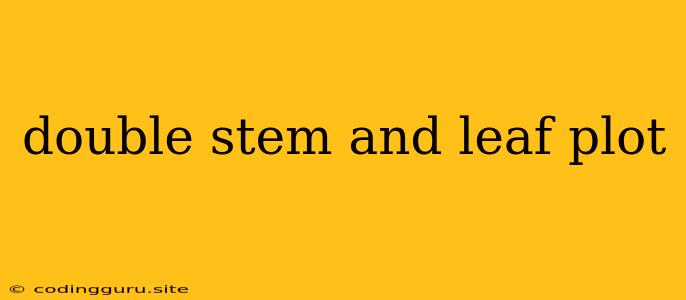Double Stem and Leaf Plot: A Powerful Tool for Data Visualization
Have you ever encountered a dataset with a wide range of values, making it difficult to analyze and understand the distribution of data? A double stem and leaf plot can be a powerful tool to overcome this challenge. This method allows you to visualize and compare two datasets simultaneously, offering a clear and concise representation of their distribution.
What is a Double Stem and Leaf Plot?
A double stem and leaf plot is a type of data visualization that uses two stems for each value. One stem represents the tens digit, and the other represents the units digit. Each leaf represents the ones digit of the corresponding data point.
For example, consider the following two datasets:
- Dataset 1: 23, 25, 28, 32, 35, 38
- Dataset 2: 21, 24, 27, 30, 33, 36
A double stem and leaf plot for these datasets would look like this:
2 | 1 3 4 5 7 8
3 | 0 2 3 5 6 8
Here's how to read the plot:
- The left stem (2) represents the tens digit for all the values in the first dataset.
- The right stem (2) represents the tens digit for all the values in the second dataset.
- The leaves (1, 3, 4, 5, 7, 8) are the units digits of each data point, ordered from least to greatest.
Why Use a Double Stem and Leaf Plot?
- Easy Comparison: A double stem and leaf plot allows you to quickly compare the distribution of two datasets side-by-side. You can immediately see if the data sets are similar or different in terms of their center, spread, and shape.
- Preserves Raw Data: Unlike other visualizations like histograms or box plots, a double stem and leaf plot preserves the original data values, enabling you to identify specific data points within each dataset.
- Compact Representation: This method allows for a compact representation of the data, making it efficient to display and analyze large datasets.
Steps to Construct a Double Stem and Leaf Plot:
- Identify the Tens Digit: Determine the tens digit for the smallest and largest values in both datasets.
- Create the Stem: Draw a vertical line and write the tens digits in increasing order on either side of the line.
- Add the Leaves: For each data point, record the ones digit as a leaf on the corresponding stem.
- Order the Leaves: Ensure the leaves on each stem are arranged in increasing order from left to right.
Example:
Let's create a double stem and leaf plot for the following two datasets:
- Dataset 1: Heights of Students in Class A (cm): 152, 158, 160, 162, 165, 168
- Dataset 2: Heights of Students in Class B (cm): 150, 155, 157, 163, 167, 170
Double Stem and Leaf Plot:
15 | 0 2 5 7 8
16 | 0 2 3 5 7 8
17 | 0
Analyzing the Double Stem and Leaf Plot:
- Distribution: Both Class A and Class B have a similar spread of heights, with the majority of students falling in the 150s and 160s.
- Central Tendency: Class B seems to have slightly taller students, with a higher concentration of values in the 160s and a few students even in the 170s.
- Outliers: There are no significant outliers in either dataset.
Advantages of a Double Stem and Leaf Plot:
- Visual Comparison: Clearly compares the distributions of two datasets.
- Data Preservation: Maintains the original data values for detailed analysis.
- Compact Representation: Efficiently displays data in a concise format.
- Easy to Construct: Relatively simple to create manually or using statistical software.
Limitations of a Double Stem and Leaf Plot:
- Limited to Small Datasets: May not be suitable for large datasets with numerous data points.
- Less Flexible Than Other Visualizations: May not be as versatile as histograms or box plots for showing specific characteristics like percentiles or quartiles.
Conclusion:
A double stem and leaf plot is a valuable tool for visualizing and comparing two datasets simultaneously. It offers a clear and concise representation of the data, allowing for quick analysis of their distribution, central tendency, and potential outliers. While it may have limitations for large datasets or specific statistical insights, it remains a useful and readily understood visualization method, particularly when comparing two groups of data.
